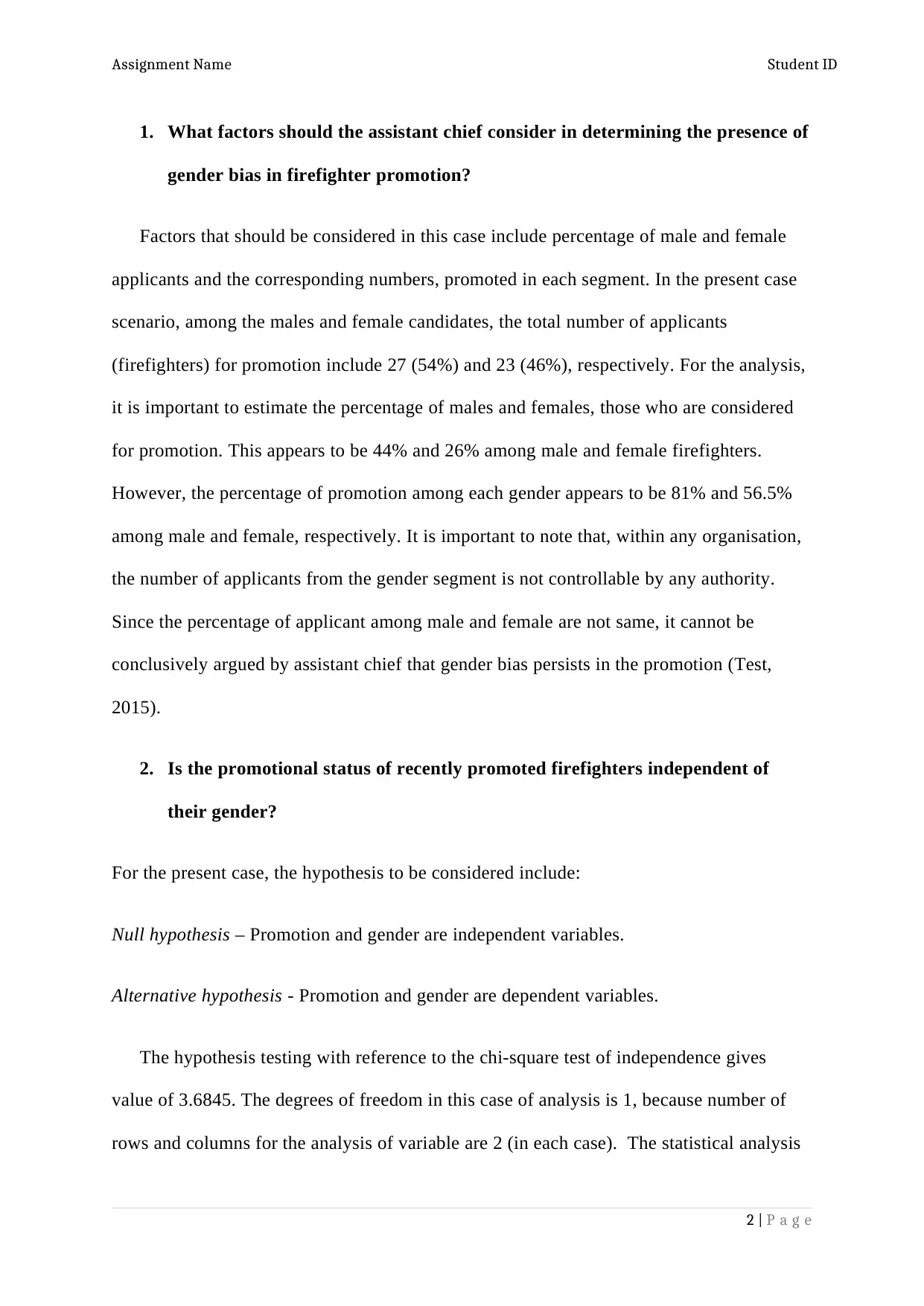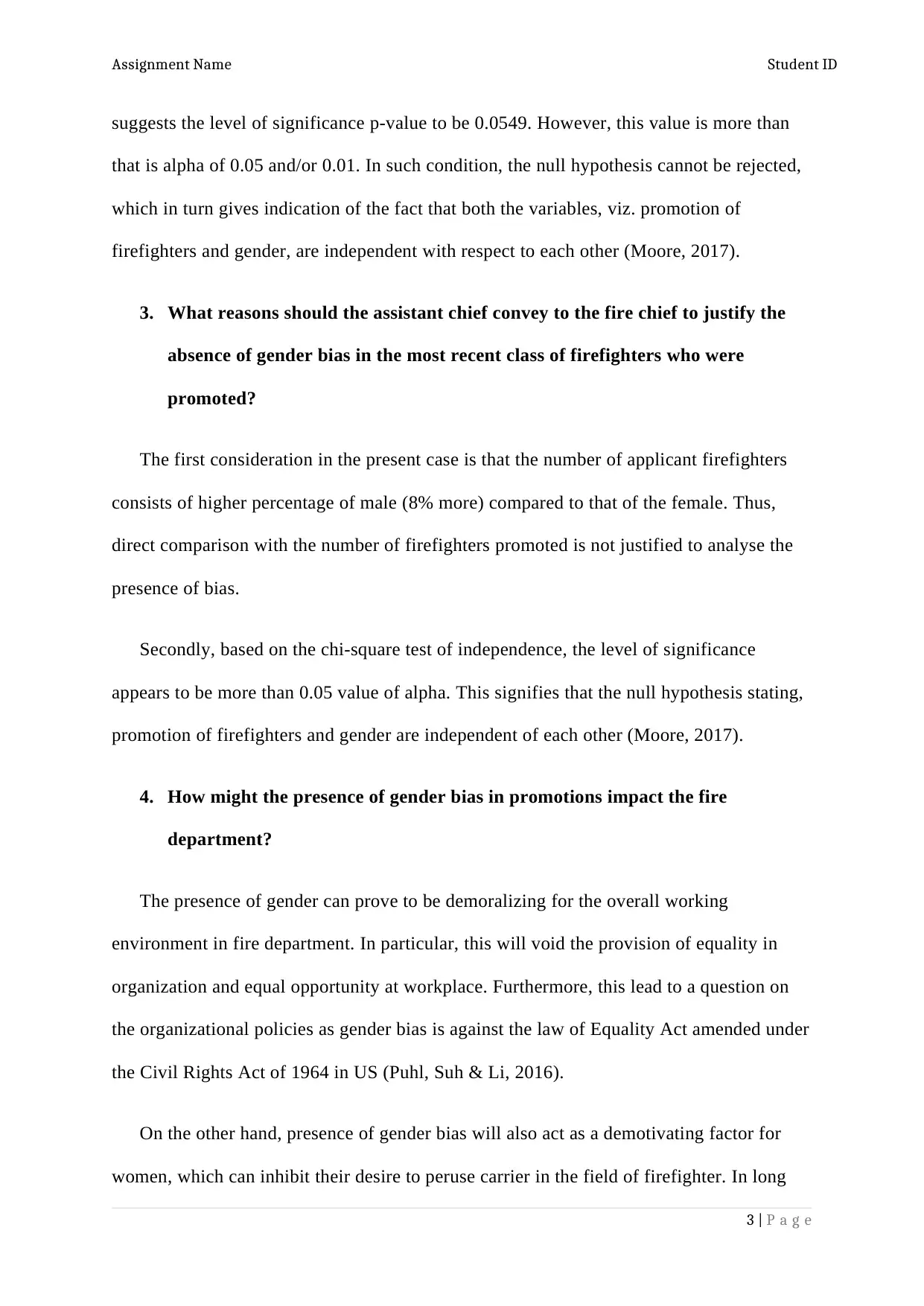QSO 510 Case Study: Analyzing Factors of Gender Bias in Promotions
VerifiedAdded on 2023/04/21
|4
|859
|415
Case Study
AI Summary
This case study analyzes the potential presence of gender bias in firefighter promotions. It examines factors such as the percentage of male and female applicants, promotion rates, and uses a chi-square test of independence to determine if promotional status is independent of gender. The analys...

Assignment Name Student ID
Assignment Name
Student ID
Course Name
15 Feb 2019
1 | P a g e
Assignment Name
Student ID
Course Name
15 Feb 2019
1 | P a g e
Paraphrase This Document
Need a fresh take? Get an instant paraphrase of this document with our AI Paraphraser

Assignment Name Student ID
1. What factors should the assistant chief consider in determining the presence of
gender bias in firefighter promotion?
Factors that should be considered in this case include percentage of male and female
applicants and the corresponding numbers, promoted in each segment. In the present case
scenario, among the males and female candidates, the total number of applicants
(firefighters) for promotion include 27 (54%) and 23 (46%), respectively. For the analysis,
it is important to estimate the percentage of males and females, those who are considered
for promotion. This appears to be 44% and 26% among male and female firefighters.
However, the percentage of promotion among each gender appears to be 81% and 56.5%
among male and female, respectively. It is important to note that, within any organisation,
the number of applicants from the gender segment is not controllable by any authority.
Since the percentage of applicant among male and female are not same, it cannot be
conclusively argued by assistant chief that gender bias persists in the promotion (Test,
2015).
2. Is the promotional status of recently promoted firefighters independent of
their gender?
For the present case, the hypothesis to be considered include:
Null hypothesis – Promotion and gender are independent variables.
Alternative hypothesis - Promotion and gender are dependent variables.
The hypothesis testing with reference to the chi-square test of independence gives
value of 3.6845. The degrees of freedom in this case of analysis is 1, because number of
rows and columns for the analysis of variable are 2 (in each case). The statistical analysis
2 | P a g e
1. What factors should the assistant chief consider in determining the presence of
gender bias in firefighter promotion?
Factors that should be considered in this case include percentage of male and female
applicants and the corresponding numbers, promoted in each segment. In the present case
scenario, among the males and female candidates, the total number of applicants
(firefighters) for promotion include 27 (54%) and 23 (46%), respectively. For the analysis,
it is important to estimate the percentage of males and females, those who are considered
for promotion. This appears to be 44% and 26% among male and female firefighters.
However, the percentage of promotion among each gender appears to be 81% and 56.5%
among male and female, respectively. It is important to note that, within any organisation,
the number of applicants from the gender segment is not controllable by any authority.
Since the percentage of applicant among male and female are not same, it cannot be
conclusively argued by assistant chief that gender bias persists in the promotion (Test,
2015).
2. Is the promotional status of recently promoted firefighters independent of
their gender?
For the present case, the hypothesis to be considered include:
Null hypothesis – Promotion and gender are independent variables.
Alternative hypothesis - Promotion and gender are dependent variables.
The hypothesis testing with reference to the chi-square test of independence gives
value of 3.6845. The degrees of freedom in this case of analysis is 1, because number of
rows and columns for the analysis of variable are 2 (in each case). The statistical analysis
2 | P a g e

Assignment Name Student ID
suggests the level of significance p-value to be 0.0549. However, this value is more than
that is alpha of 0.05 and/or 0.01. In such condition, the null hypothesis cannot be rejected,
which in turn gives indication of the fact that both the variables, viz. promotion of
firefighters and gender, are independent with respect to each other (Moore, 2017).
3. What reasons should the assistant chief convey to the fire chief to justify the
absence of gender bias in the most recent class of firefighters who were
promoted?
The first consideration in the present case is that the number of applicant firefighters
consists of higher percentage of male (8% more) compared to that of the female. Thus,
direct comparison with the number of firefighters promoted is not justified to analyse the
presence of bias.
Secondly, based on the chi-square test of independence, the level of significance
appears to be more than 0.05 value of alpha. This signifies that the null hypothesis stating,
promotion of firefighters and gender are independent of each other (Moore, 2017).
4. How might the presence of gender bias in promotions impact the fire
department?
The presence of gender can prove to be demoralizing for the overall working
environment in fire department. In particular, this will void the provision of equality in
organization and equal opportunity at workplace. Furthermore, this lead to a question on
the organizational policies as gender bias is against the law of Equality Act amended under
the Civil Rights Act of 1964 in US (Puhl, Suh & Li, 2016).
On the other hand, presence of gender bias will also act as a demotivating factor for
women, which can inhibit their desire to peruse carrier in the field of firefighter. In long
3 | P a g e
suggests the level of significance p-value to be 0.0549. However, this value is more than
that is alpha of 0.05 and/or 0.01. In such condition, the null hypothesis cannot be rejected,
which in turn gives indication of the fact that both the variables, viz. promotion of
firefighters and gender, are independent with respect to each other (Moore, 2017).
3. What reasons should the assistant chief convey to the fire chief to justify the
absence of gender bias in the most recent class of firefighters who were
promoted?
The first consideration in the present case is that the number of applicant firefighters
consists of higher percentage of male (8% more) compared to that of the female. Thus,
direct comparison with the number of firefighters promoted is not justified to analyse the
presence of bias.
Secondly, based on the chi-square test of independence, the level of significance
appears to be more than 0.05 value of alpha. This signifies that the null hypothesis stating,
promotion of firefighters and gender are independent of each other (Moore, 2017).
4. How might the presence of gender bias in promotions impact the fire
department?
The presence of gender can prove to be demoralizing for the overall working
environment in fire department. In particular, this will void the provision of equality in
organization and equal opportunity at workplace. Furthermore, this lead to a question on
the organizational policies as gender bias is against the law of Equality Act amended under
the Civil Rights Act of 1964 in US (Puhl, Suh & Li, 2016).
On the other hand, presence of gender bias will also act as a demotivating factor for
women, which can inhibit their desire to peruse carrier in the field of firefighter. In long
3 | P a g e
⊘ This is a preview!⊘
Do you want full access?
Subscribe today to unlock all pages.

Trusted by 1+ million students worldwide

Assignment Name Student ID
run, this can lead to shortage of potential employee, where contribution from women will
be reduced. Additionally, for the existing employees this will act as a factor for generating
negative emotion within workplace that ultimately will affect the performativity of the
organisation (Ntim, 2015).
References:
Moore, D.S., 2017. Tests of chi-squared type. In Goodness-of-Fit-Techniques (pp. 63-96).
Routledge.
Ntim, C. G. (2015). Board diversity and organizational valuation: unravelling the effects of
ethnicity and gender. Journal of Management & Governance, 19(1), 167-195.
Puhl, R. M., Suh, Y., & Li, X. (2016). Legislating for weight-based equality: national trends
in public support for laws to prohibit weight discrimination. International journal of
Obesity, 40(8), 1320.
Test, O. (2015). Your chi-square test is statistically significant±now what. Pract Assess Res
Eval, 20(8), 2-10.
4 | P a g e
run, this can lead to shortage of potential employee, where contribution from women will
be reduced. Additionally, for the existing employees this will act as a factor for generating
negative emotion within workplace that ultimately will affect the performativity of the
organisation (Ntim, 2015).
References:
Moore, D.S., 2017. Tests of chi-squared type. In Goodness-of-Fit-Techniques (pp. 63-96).
Routledge.
Ntim, C. G. (2015). Board diversity and organizational valuation: unravelling the effects of
ethnicity and gender. Journal of Management & Governance, 19(1), 167-195.
Puhl, R. M., Suh, Y., & Li, X. (2016). Legislating for weight-based equality: national trends
in public support for laws to prohibit weight discrimination. International journal of
Obesity, 40(8), 1320.
Test, O. (2015). Your chi-square test is statistically significant±now what. Pract Assess Res
Eval, 20(8), 2-10.
4 | P a g e
1 out of 4
Related Documents
Your All-in-One AI-Powered Toolkit for Academic Success.
+13062052269
info@desklib.com
Available 24*7 on WhatsApp / Email
![[object Object]](/_next/static/media/star-bottom.7253800d.svg)
Unlock your academic potential
© 2024 | Zucol Services PVT LTD | All rights reserved.




